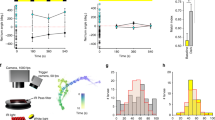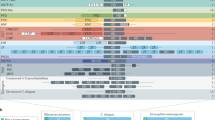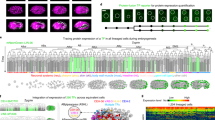Abstract
MANY animals with overall bilateral symmetry also exhibit some left–right asymmetries with generally invariant handedness. Therefore, the left–right embryonic axis must have a consistent polarity, whose origins and subsequent effects on development are not understood (reviewed in ref. 1). Caenorhabditis elegans exhibits such left–right asymmetries at all developmental stages. The embryonic cell lineage is asymmetric as well: although the animal is generally bilaterally symmetric, many of its contralaterally analogous cells arise from different lineages on the two sides of the embryo2,3. I accomplished reversal of embryonic handedness by micromanipulation at the 6-cell stage, which resulted in mirror-image but otherwise normal development into healthy, fertile animals with all the usual left–right asymmetries reversed. This result demonstrates that in the 6-cell embryo the pair of anterior (AB) blastomeres on the right is equivalent to the pair on the left, and that the extensive differences in fates between lineally homologous derivatives of these cells on the two sides of the animal must be dictated by cell interactions, most of which are likely to occur early in embryogenesis.
This is a preview of subscription content, access via your institution
Access options
Subscribe to this journal
Receive 51 print issues and online access
$199.00 per year
only $3.90 per issue
Buy this article
- Purchase on Springer Link
- Instant access to full article PDF
Prices may be subject to local taxes which are calculated during checkout
Similar content being viewed by others
References
Brown, N. A. & Wolpert, L. Development 109, 1–9 (1990).
Sulston, J. E. et al., Devl Biol. 100, 64–119 (1983).
Sulston, J. E. Cold Spring Harb. Symp. quant. Biol. 48, 443–452 (1983).
Sulston, J. E. & Horvitz, H. R. Devl Biol. 56, 110–156 (1977).
White, J. G. et al. Phil. Trans. R. Soc. 314, 1–340 (1986).
White, J. in The Nematode Caenorhabditis elegans (ed. Wood, W. B.) 81–122 (Cold Spring Harbor, Laboratory, New York,, 1988).
Priess, J. & Thomson, J. N. Cell 48, 241–250 (1987).
zur Strassen, O. Arch. EntwMech. Org. 3, 27–105 (1896).
Dünschen, F. Arch. EntwMech. Org. 115, 237–335 (1929).
Bonfig, R. Z. Wissensch. Zool. 124, 407–456 (1925).
Laufer, J. S., Bazzicalupo, P. & Wood, W. B. Cell 19, 569–577 (1980).
Cowan, A. E. & Mclntosh, J. R. Cell 41, 923–932 (1985).
Edgar, L. G. & McGhee, J. D. Cell 53, 589–599 (1988).
Schierenberg, E. Devl Biol. 122, 452–463 (1987).
Priess, J. R., Schnabel, H. & Schnabel, R. Cell 51, 601–611 (1987).
Yochem, J. & Greenwald, I. Cell 58, 553–563 (1989).
Sulston, J. & Hodgkin, J. in The Nematode Caenorhabditis elegans (ed. Wood, W. B.) 587–606 (Cold Spring Harbor Laboratory, New York, 1988).
Deppe, U. et al. Proc. natn. Acad. Sci. U.S.A. 75, 376–380 (1978).
Author information
Authors and Affiliations
Rights and permissions
About this article
Cite this article
Wood, W. Evidence from reversal of handedness in C. elegans embryos for early cell interactions determining cell fates. Nature 349, 536–538 (1991). https://doi.org/10.1038/349536a0
Received:
Accepted:
Issue Date:
DOI: https://doi.org/10.1038/349536a0
This article is cited by
-
Plectus - a stepping stone in embryonic cell lineage evolution of nematodes
EvoDevo (2012)
-
Possible Origins of Macroscopic Left-Right Asymmetry in Organisms
Journal of Statistical Physics (2012)
-
Asymmetry with a twist
Nature (2009)
-
Chiral blastomere arrangement dictates zygotic left–right asymmetry pathway in snails
Nature (2009)
-
Left–right asymmetry in the nervous system: the Caenorhabditis elegans model
Nature Reviews Neuroscience (2002)
Comments
By submitting a comment you agree to abide by our Terms and Community Guidelines. If you find something abusive or that does not comply with our terms or guidelines please flag it as inappropriate.



